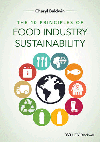
Tightening The Food Chain
Biosecurity remains a hot-button issue, in light of
new regulations and proactive measures.
This month marks the third
anniversary of the attacks on the World Trade Center in New York City and
the Pentagon in Washington, D.C., events which led to unprecedented
scrutiny of the security of the nation. It wasn’t long after
September 11, in fact, that the country’s food supply became a focus
of anti-terrorism efforts and initiatives.
The potential for bioterrorism has loomed large on the
agendas of both government officials who must prepare for such
possibilities as well as food and beverage manufacturers who produce,
export and import products that could be considered vulnerable to any kind
of intentional tampering, from international or domestic culprits.
The scenarios may range from the improbable to the
downright frightening, but one thing is certain: Processors are working
diligently on measures to combat any potential attacks and to comply with
government regulations, while still providing input on realities and
practicalities.
“The government talks about terrorist attacks
involving any type of industry out there, including the food industry.
Although I think the odds are probably fairly low, you cannot be sure and
the ramifications could be quite severe,” says Clay Detlefsen, vice
president of regulatory affairs and counsel for the Washington, D.C.-based
International Dairy Foods Association (IDFA). “If we’ve done
one thing to stop something, then we’ve done a good thing.”
From a regulatory side, dairy industry organizations
and manufacturers have been closely tracking the regulations stemming from
the Bioterrorism Act of 2002, which was designed to enhance Food and Drug
Administration’s (FDA) authority to protect the nation’s
food supply against terrorist threats or similar food safety emergencies.
Just under a year ago, in October 2003, the FDA
announced the release of interim final rules for the registration of food
facilities and for the prior notice of imported food shipments. A third
rule on administrative detention of suspect food products was released in
June, while the fourth interim rule, pertaining to the establishment and
maintenance of recordkeeping, is expected to be released by the end of
2004, after a series of delays.
For its part, IDFA has worked to provide industry
insight, recommendations and, in some cases, objections on the proposed
regulations. “They opened it up to comments before they even drafted
anything. FDA was extremely diligent in trying to get industry’s
perspective and all concerned parties have been involved in an enormous
amount of discussions,” says Detlefsen, noting that IDFA has filed
comments on at least six occasions in addition to regularly attending
meetings.
The industry’s comments were effective in making
some changes to proposed rules, says Detlefsen. “The major problem we
saw early on was in their definition of food. At one point, it actually
covered anything that touched food — a plate, a pipe, a truck. But
FDA looked beyond it, figured it out and got it right.”
IDFA is also working with its members to update them
about the bioterrorism regulations and their potential impact. The group
held a dedicated workshop on the topic in late 2003 and has included
biosecurity on the agenda of other workshops and conferences.
In addition, IDFA has organized a member committee on
biosecurity, which has drawn at least 60 participants. “It is a
pretty good indicator that there is a lot of interest in this,” says
Detlefsen.
Other industry bodies have carefully monitored the
regulations as well. “Here in Wisconsin, we formed a committee for
the assurance of dairy product safety, and we included a section on
biosecurity,” says Marianne Smukowski, safety quality applications
coordinator for the Wisconsin Center for Dairy Research at the University
of Wisconsin-Madison. “A lot of folks are still waiting to see the
final rules on that (topic).”
Dairy Management Inc. (DMI), Rosemont, Ill., also has
worked on biosecurity issues management, which may become an even greater
focus of industry-funded efforts. “I think we’ll be looking at
safety and biosecurity, to see if there is need for new research,”
observes Bill Haines, DMI’s vice president of product innovation,
adding that traceability will likely become an increasingly key issue tied
to security.
In addition to keeping informed of current and pending
regulations, dairy processors have taken proactive measures on the
biosecurity front. Often, the responsibility for such firewalls falls on
the same individuals responsible for food safety, although some
manufacturers have hired or contracted with security experts.
Steps to combat potential bioterrorism vary. “We
have focused most of our efforts on physical things such as sealing trucks,
inbound and outbound,” says Carl Schroeder, vice president of
manufacturing for Schroeder Dairy Co., Maplewood, Minn. “We have also
installed security systems like badge readers, which limit access, and have
trained employees to be alert and aware of who is in the facility.”
Stonyfield Farm, Londonderry, N.H., also has changed
some of its operations and policies in light of a changing world.
“Stonyfield Farm has implemented a dozen food security measure
enhancements including improvement of physical barriers, new procedures,
and management and employee training over the past year,” says Alton
Bradshaw, director of corporate and regulatory compliance.
Ben & Jerry’s, South Burlington, Vt., has
taken a fresh look at security as well, and focuses on the company’s
key gatekeepers, according to director of public relations Chrystie
Heimert. “Employee awareness has to be the most significant change to
the new environment,” she says. “Shipping and receiving
personnel vigilance are critical to the process, and careful attention to
our plant security systems is another line of defense.”
Some processors are working with third parties to
identify gaps in their security situation. Homewood, Ill.-based Silliker
Laboratories, for example, provides such evaluations as part of its overall
food safety services. This year, the company added a separate scored
section onto food security to one of its food safety audit tools.
“That was something we determined was needed,
and our customers were asking for it as well,” says Rena Pierami,
division vice president. “We are looking at various levels within
security, from facilities to people to records. For the facilities, we ask
things like, are the grounds protected? How did they determine if
protection was needed? Internally, it’s the same thing: Is access
restricted? Can a visitor get around the facility?
Although Silliker offers risk assessments, the company
does not offer specific suggestions on measures, leaving such decisions up
to its clients.
Pierami stresses thoughtful planning when it comes to
matters of such importance. “It doesn’t matter who it
is,” she says. “They have to have firewalls in place and have
to think about what they are doing.” df
$OMN_arttitle="Tightening The Food Chain";?>


